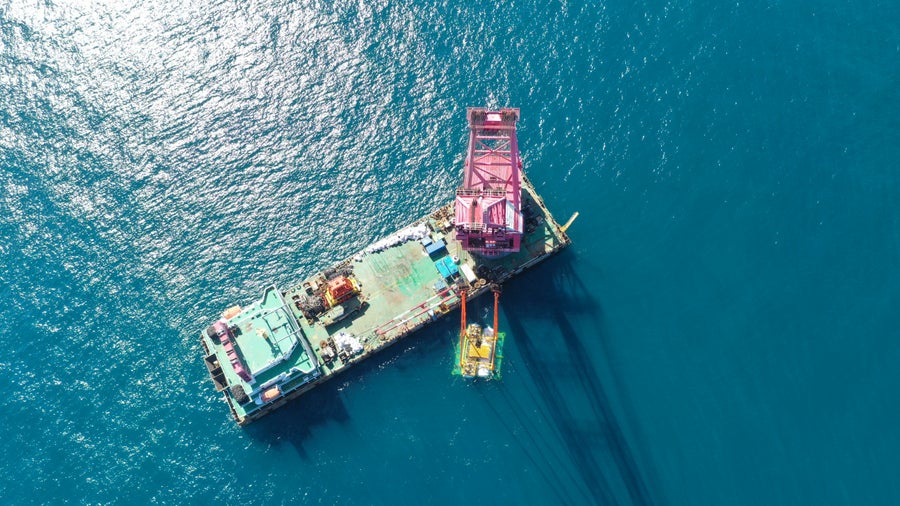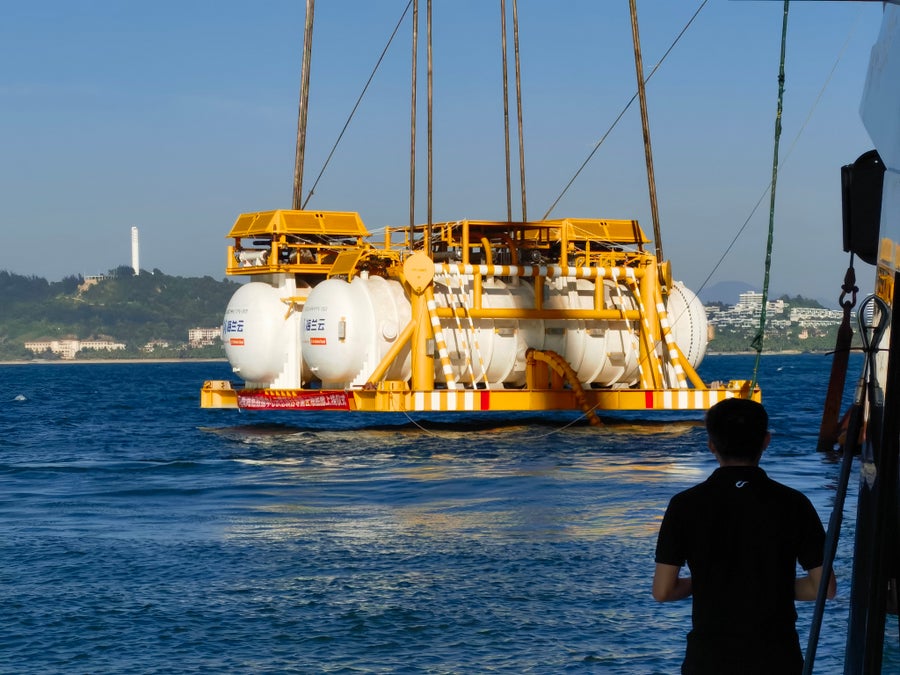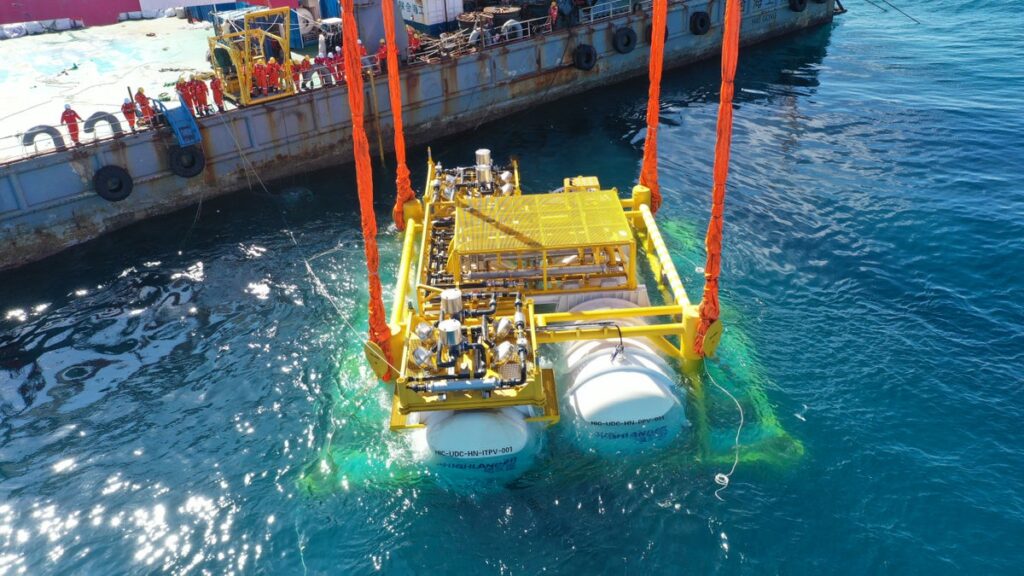To grow its economy, China is betting big on artificial intelligence, cloud computing and other digital technology—and a big part of that bet involves rapidly building data centers to boost computing power. But these massive collections of servers gobble up growing amounts of energy, and each one cycles through hundreds of thousands of gallons of water a day to carry away the heat they generate.
That means these facilities—in China and beyond—will increasingly compete with water demand linked directly to human survival, from agriculture to daily drinking. Many companies have sited their data centers in some of the driest regions of the world, including Arizona, parts of Spain, and the Middle East, because dry air reduces the risks of damage to the equipment from humidity, according to an investigation by the nonprofit journalist organization SourceMaterial and the Guardian. Partly to address water concerns, China is now putting a data center in the wettest place there is: the ocean. This June construction began on a wind-powered underwater data center about six miles off the coast of Shanghai, one of China’s AI hubs. [Read more: What Do Google’s AI Answers Cost the Environment?]
“China’s ambitious approach signals a bold shift toward low-carbon digital infrastructure, and it could influence global norms in sustainable computing,” says Shabrina Nadhila, an analyst at energy-focused think tank Ember, who has researched data centers.
On supporting science journalism
If you’re enjoying this article, consider supporting our award-winning journalism by subscribing. By purchasing a subscription you are helping to ensure the future of impactful stories about the discoveries and ideas shaping our world today.
Keeping Data Centers Cool
Data centers store information and perform complex calculations for businesses, whose increasing automation is steadily ramping up such needs. These facilities consume vast amounts of electricity and water because their servers work nonstop and in close proximity—and they generate waste heat as a by-product, which can damage equipment and destroy data. So they need to be constantly cooled.
Roughly 40 percent of the electricity consumed by an ordinary data center is for this purpose. Most of that energy is used to chill water, which is sprayed into the air that circulates around the servers or is allowed to evaporate near them, lowering their temperatures. That water can come from underground, from nearby rivers or streams, or from reclaimed wastewater.
An artist’s rendering of a wind-powered underwater data center being built off the coast of Shanghai.
Shanghai Hailanyun Technology
Instead undersea data centers use pipes to pump seawater through a radiator on the back of server racks to absorb heat and carry it away. Hailanyun—the company sometimes referred to as HiCloud that is behind the Shanghai data center—says an assessment conducted with the China Academy of Information and Communications Technology shows its project uses at least 30 percent less electricity than on-land data centers, thanks to natural cooling.
The Shanghai center will also be connected to a nearby offshore wind farm that is set to supply 97 percent of its energy, says Hailanyun spokesperson Li Langping.
The project’s first phase is designed to contain 198 server racks—enough to hold 396 to 792 AI-capable servers—and is slated to begin operation in September, Li says. It is expected to provide enough computing power to complete the equivalent of training GPT-3.5—the large language model that OpenAI released in 2022 and used to fine-tune ChatGPT—in the space of a day, he adds. Yet Hailanyun’s Shanghai center is small compared with a typical land-based one: a medium-scale data center in China normally has up to 3,000 standard racks, while a superscale version can contain more than 10,000.
Leapfrogging the U.S.
At the core of Hailanyun’s $223-million Shanghai gambit is a technology that Microsoft pioneered more than a decade ago under an effort called Project Natick, in which the company sank a shipping-container-sized capsule holding more than 800 servers 117 feet below the surface off the coast of Scotland. After hauling up the pod two years later, Microsoft found that underwater data centers “are reliable, practical and use energy sustainably.”
The experiment also resulted in fewer broken servers compared with on-land data centers because the vessel was sealed off and filled with nitrogen, which is less corrosive than oxygen, Microsoft said in a 2020 press release. The lack of people also meant that the equipment avoided physical contacts or movements that may otherwise cause them damage in an on-land center, the company said.

Hailanyun places the first phase of its underwater data center into the ocean off the coast of Hainan in December 2022.
Shanghai Hailanyun Technology
But Microsoft has reportedly shelved Project Natick. A company spokesperson did not answer questions about whether or not the project was terminated. Instead, they provided a statement: “While we don’t currently have data centers in the water, we will continue to use Project Natick as a research platform to explore, test, and validate new concepts around data center reliability and sustainability.”
Hailanyun aims to leapfrog American companies: if the Shanghai project is successful, Li expects his company to springboard toward large-scale deployments of offshore, wind-powered undersea data centers with the support of the Chinese government.
Zhang Ning, a postdoctoral researcher at the University of California, Davis, who specializes in next-generation low-carbon infrastructure, notes that Hailanyun has moved from a pilot project conducted in Hainan in December 2022 to commercial rollouts in less than 30 months—“something Microsoft’s Project Natick never attempted.”
Environmental Concerns
In spite of the apparent benefits of underwater data centers, some concerns remain—especially over potential environmental impacts. Microsoft researchers found their pod had caused some localized warming in the sea, though the impact was limited. “The water just meters downstream of a Natick vessel would get a few thousandths of a degree warmer at most,” they wrote.
But other researchers say submerged data centers could harm aquatic biodiversity during a marine heat wave—a period of unusually high ocean temperatures. In those cases, the outlet water from the vessel would be even warmer and hold less of the oxygen that aquatic creatures need to survive, a 2022 paper said.

Two water-tight containers carrying servers and other equipment are lowered into the ocean off the coast of Hainan as part of China’s first commercial underwater data center in November 2023.
Shanghai Hailanyun Technology
Another concern is security. A 2024 study found that undersea data centers can be destroyed by certain noises carried out by underwater speaker systems, which raises concerns about malicious attacks using sound.
In response to such concerns, Hailanyun says its undersea data centers are “environmentally friendly,” citing an assessment conducted on one of its test pods in southern China’s Pearl River in 2020. “The heat dissipated by the undersea data center caused less than one degree of temperature rise in the surrounding water,” Li says. “It virtually did not cause any substantial impact.”
The undersea data center concept seems to have growing appeal beyond China. Countries including South Korea have also announced plans to pursue them, while Japan and Singapore are mulling data centers that float on the ocean’s surface instead.
Zhang says that whether other coastal areas will dive into the trend hinges less on technical feasibility and more on how quickly would-be operators can resolve the regulatory, ecological and supply-chain questions that “China is now tackling at scale.”


